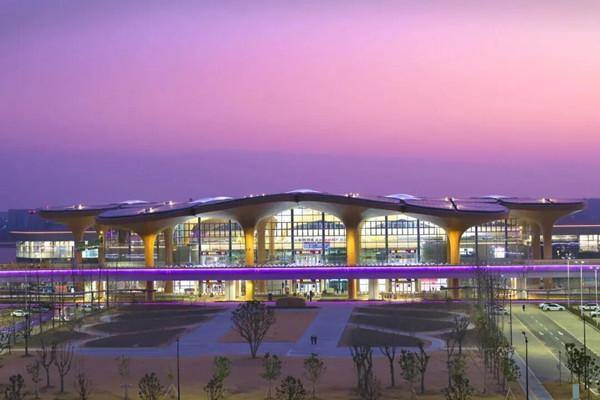Some foreign media say China's economic growth target of about 5.5 percent is too high, and its economic prospects are unattainable. Many Chinese researchers agree with that, saying that achieving this year's economic growth target will be challenging.
The"2022 White Paper on the Business Environment in China" and the "2022 Special Report on the State of Business in South China", were both produced and published by the American Chamber of Commerce in South China (AmCham South China) and released on March 1, show that foreign-invested enterprises have played, and continue to play, a highly substantial role in China's development and prosperity. These enterprises take pride in past accomplishments and want to continue to work hand in hand to help overcome the challenges that lie ahead.
Notwithstanding the challenges facing all companies, these studies show that China remains the number one destination for reinvestment by a majority of US and European countries, and those other countries which have participated in our studies. Guangzhou, followed by Shenzhen, Shanghai, and Beijing has been voted as the best reinvestment destinations in China.
Besides, Premier Li Keqiang has said that achieving the government's GDP growth goal will be "not easy", and pledged to implement policy measures that would generate more jobs to curb a sharp downturn in the economy. He said: "This kind of steady progress is very important in itself, and it needs to be enabled by the support of a series of macroeconomic policies" such as the creation of "more than 11 million, or preferably over 13 million" new urban jobs. Li also promised tax breaks aimed at propping up the corporate sector at a scale of 2.5 trillion yuan ($392.56 billion).
China has become an important player on the world stage. Yet, according to the Central Economic Work Conference at the end of 2021, China's economic development would face triple pressure in the near future-from demand contraction, supply shocks, and deteriorating expectations.
The Chinese economy started 2022 on an uncertain footing, as COVID-19 flareups disrupted factory activity and consumer spending. Overseas demand, too, contracted at a faster-than-usual rate, as the rapid spread of the Omicron variant of the novel coronavirus dampened global consumer sentiment.
Many extenuating circumstances this year, including outbreaks and how China overcomes future outbreaks, will impact the ability of China to reach its goals. Having sufficient power generation to prevent future shortages could also take a toll if last year's rolling energy blackouts return.
While the Chinese leaders have emphasized the importance of orienting the country's economy more toward domestic consumption, that effort has repeatedly been hindered by new COVID-19 outbreaks and the government's strict measures to contain them. China has seen positive changes in its economic performance backed up by surprisingly good economic data, but the impacts of the latest COVID-19 resurgence need to be watched.
As costs for many raw materials have risen, and the pandemic has compelled some consumers to stay home, millions of private businesses have suffered, most of them small and family-owned. That is a big concern because private companies are the backbone of the Chinese economy, accounting for three-fifths of output and four-fifths of urban employment. We suggest that every effort be made to support the small and family-owned businesses which very often lack the ability to borrow from banks to ride out the storm.
This month, the Chinese mainland has seen its worst COVID-19 outbreak since the height of the pandemic in early 2020-when the economy suffered a blow. But economic loss may be real this time, a Citigroup report claimed, estimating the outbreak could hit China's first quarter GDP by at least 0.5 percentage points since the most affected regions account for 16.7 percent of national GDP. Considering the combined spillover effect of other regions' lockdown and tightened quarantine measures, this round could potentially deduct about 0.5-0.8 percentage points of GDP growth in the first quarter, assuming no policy responses. That being said, the number of new cases is still far lower than in other parts of the world such as Europe.
Bank of America Securities' China equity strategy team claims that if the pandemic is managed well, the outbreaks could help China prepare to reopen its borders. But if not, the Omicron wave "could cause significant downside to China's GDP growth and disruption to the global supply chains in the near term, and potentially accelerate the decoupling and supply chain relocation in the medium term".
Economists widely expect Beijing to roll out more easing measures as leaders have promised to give priority to stability. And to ensure stability in the market, China will require sufficient power generation in order to propel its economic machine.
AmCham South China's "2022 Special Report on the State of Business in South China" shows that its members and those of other countries which participated in its studies, have doubled their budgets for 2022 from 2021 to reinvest in projects of $250 million or larger. In 2021, 5 percent of companies had each budgeted $250 million or more while this year 10 percent of the companies have budgeted to do so.
This will, however, be possible only when China allows foreign experts needed to import and install the advanced technology equipment and production lines required by these large investments. It is important to keep in mind that the foreign personnel who are already in China are primarily operators of existing factories, and expatriate expert builders are needed for new greenfield projects. China's central authorities need to continue to ease rules for the Foreign Talent (R) visa for high-level foreign professionals in science, international enterprises, and other high-demand fields to develop the economy.
More changes will provide greater flexibility for individuals who qualify as high-level foreign talents and are intended to attract more top international talents to China for industries such as energy production. Further relaxation of visas for foreign experts is also needed to build the new factories with new technologies which will increase GDP through improved productivity and production of new and modern products needed for the growth of consumerism.
China will achieve its economic goal by taking proper steps to further open up the economy, making it easier for small businesses and young minds to use innovative means to propel China into the next phase and a host of other reforms.
Editor: Fan Wenwu




